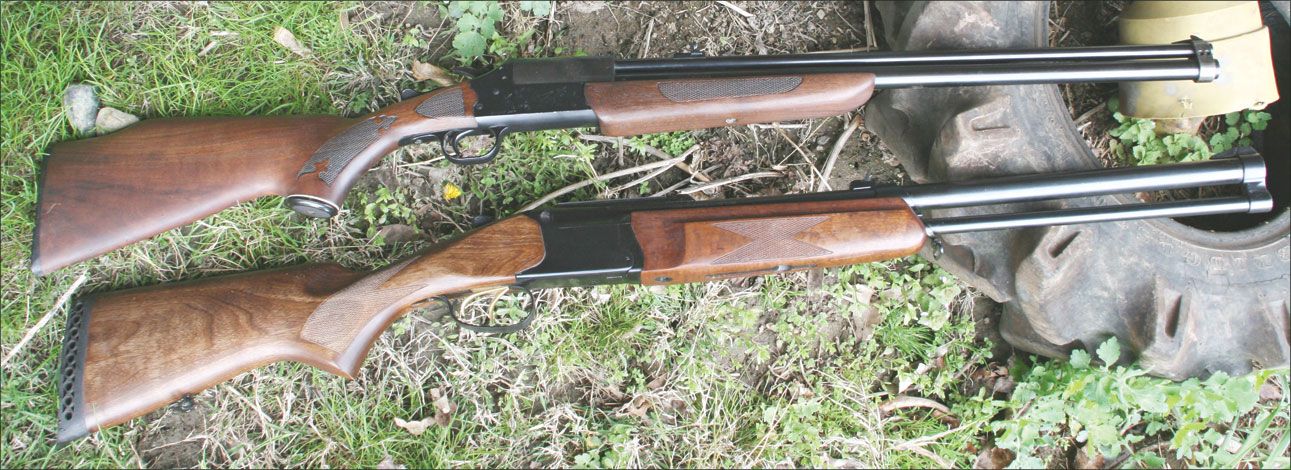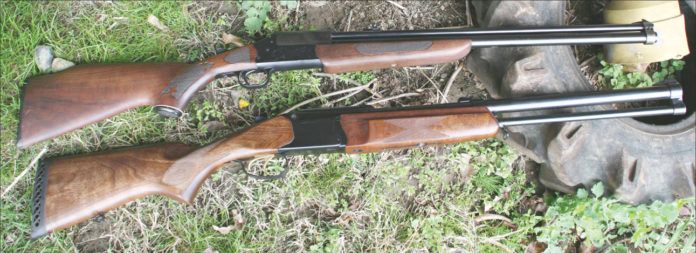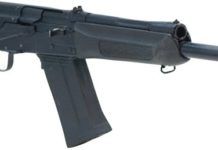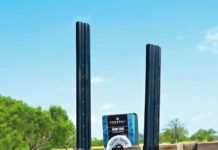Members of our staff have been afield hog hunting and walked into a mess of quail and wished for a shotgun to knock down a bird or two. Or weve been grouse hunting with a shotgun and saw a nice rabbit pop out 45 yards away, making us want a rifle. The solution in both cases would have been a combination rifle and shotgun. Though far less popular in the United States than in Europe, combo guns such as the Savage Model 24V, .222 Rem./20 gauge, $400-$425 and the Baikal Model MP94 #489330 223 Rem./12 gauge, $790, have a legitimate place in the birding/game sportsmans gun closet.

The 24V and MP94 are break-action firearms with two barrels in an over-and-under configuration. One barrel is a rifle barrel, the other is a shotgun barrel. Combo guns are designed for hunting, and depending on the caliber and gauge, a variety of game can be stalked, from rodents in a barn to whitetails in the big woods, or perhaps pigeons, pheasant, or ducks. They are guns for opportunistic hunters, since the barrel set up allows the hunters to bag a squirrel, or if by chance a grouse, or whatever game the hunter happens to comes upon. In that respect they are flexible, but since a rifle is aimed and shotguns are pointed, their features compromise elements of both firearms types. Getting the balance right is the trick.
Probably the most common combination gun manufactured in the U.S. was the Savage Model 24, an iconic firearm that was first produced in 1949. We were able to lay our hands on a Model 24V specimen built in 1968 to test as a used gun versus Baikal MP94, which was first imported from Russia in about 2001. The reason for that pairing: Savage doesnt continue to make a larger-bore shotgun model to compare to the 12-gauge Baikals. Savage has only one combination gun still listed on its website, the Model 42, a 22 LR or 22 Magnum over 410-bore gun that lists for $485 (#19666). We hope to put Savages smaller combo gun up against Baikals #489392, the MP94 set up as a 410-bore/22 LR ($562) or the #489394, a 410/22WMR ($511). Interestingly, Baikal still produces several combo guns, our #489330 12/223 Rem., the #489338 12/30-06 Springfield, the #489334 12/308 Rem., and the #489342 12/7.62×39, all $790. We reviewed and recommended the European American Armory-imported Baikal IZH94 12 gauge/7.62x39mm in the July 2002 issue, when it sold for a paltry $425.
How We Tested
We ran a number of rounds through these rifle/shotguns, shooting rifle cartridges, shotshells, and slugs at 50 yards for the rifles and slugs using open sights and patterning the shotshells at 25 yards.
For shotshells in the Savage 24V, we used Remington 20-gauge Sluggers (23⁄4-inch shell, 1⁄2-ounce slug), which produced muzzle velocity of 1795 fps and muzzle energy of 1565 foot-pounds and 3.4-inch groups at 50 yards. To pattern the Savage Model 24V, we used Remington 23⁄4-inch 20-gauge shotshells filled with 7⁄8 ounce of No. 71⁄2 shot. Pattern Size was 23 inches at 25 yards. In the Savage, Fiocchi 222 Rem. 50-grain V-Max cartridges had muzzle velocity of 3104 fps and muzzle energy of 1070 foot-pounds and had an average five-shot group size of 1.6 inches at 50 yards.
In the Baikal, we fired Winchester 12-gauge Super-X HP Rifled Slugs (23⁄4-inch shell, 1-ounce slug), which produced muzzle velocity of 1600 fps and muzzle energy of 2488 foot-pounds and 3.0-inch groups at 50 yards. To pattern the Baikal MP94, we used Federal 12-gauge 23⁄4-inch Game-Shok Upland Game shotshells filled with 1 ounce of No. 71⁄2 shot. To collect pattern data, we fired at a distance of 25 yards. Pattern size was 20 inches. In the Baikal, American Eagle 223 Rem. 50-grain jacketed hollowpoints had muzzle velocity of 3118 fps and muzzle energy of 1079 foot-pounds and had an average five-shot group size of 1.0 inches at 50 yards. Federal V-Shok 43-grain rounds popped out of the Baikal at 3536 fps with 1194 foot-pounds of energy. They shot 1.4-inch groups at 50 yards. Heres how the combo guns fared in more detail:
Savage Model 24V 222 Rem./3-Inch 20 Gauge, $400-$425
The Model 24V we had on hand was used but still had much of its bluing. However, the checkering on the pistol grip was smoothed with use. It had a 222 Rem. barrel positioned over a 3-inch chamber 20 gauge. The Baikal had that set up reversed, with the shotgun barrel over its rifle barrel. The Savage shotgun barrel had a fixed Improved Cylinder choke. The Model 24V had a fixed ramped front sight with serrations to reduce glare and a folding rear sight. Testers liked that the sight could be folded when using the combo as a shotgun or quickly flipped up to shoot the rifle barrel. All sight adjustments were made at the rear sight. It was also drilled and tapped should you want to mount an optic.
If this were a dedicated turkey or deer gun, testers thought they would mount an optic, though that would make the combo less useful for shooting birds on the fly.
To open the action, the shooter swings the top lever to the right. The blued-steel action and the frame sported simple engravings of a running fox on one side and grouse in flight on the other. Both chambers used extractors. Since the 222 Rem. is a rimless cartridge, an extractor plunger snapped into the rim of the 222 Rem. to grab the cartridge base for removal. The Savage had a hammer that was cocked by the thumb of users shooting hand. A knurled lever built into the hammer allowed a shooter to choose which barrel to fire. Up was the rifle barrel, rotate it down to fire the shotgun barrel. The hammer was nicely grooved for a sure grip. There is no safety except for a half-cock safety on the hammer.
The wood stock had what looked like pressed checkering in the forend and pistol grip area. It sported a white spacer on the grip cap and a hard buttpad. The buttstock had a slightly raised comb.
At the time we tested, we could only find one readily available brand of 222 Rem. ammo. We used 20-gauge reloads to get used to the Savage, then switched to Remington factory Game Loads and Remington rifled slugs for data collection. These combo guns are versatile because of the types of ammunition they can digest. We fired the little Savage using open sights at targets placed at 25 yards for the shotgun patterning and at 50 yards for rifle and slug testing. Though the trigger was not anywhere near crisp, we were able to produce acceptable groups. And it patterned well enough to shoot grouse on the fly.
Testers found the barrel selector lever in the hammer took some getting used to, but ramp-up time was short. The gun needed to be opened completely to extract the 20-gauge empty, but loading the rifle was easier than the Baikal.
Our Team Said: The Savage Model 24V performed well and would be a good choice for shooters who have a low tolerance for recoil, yet still wanted a suitable hunting gun. We should note the slugs did have a bit of a kick. Our testers thought it would also serve well as a survival or bug-out firearm because of the numerous types of ammo it could fire – rifle ammunition, shotshells, and slugs. Most felt they would want 223 Rem. instead of 222 Rem., as the former cartridge is more common. Rechambering wouldnt be a big job for a quality gunsmith.
Baikal Model MP94 #489330 223 Rem./3-inch 12 Gauge, $790
The Baikal MP94 is an updated combo that looks similar to Savage Model 24V but uses a simple box lock with internal hammers. The combo was also marked IZH 94, which was the model number of the gun when it was first imported to the states by EAA. Break open the Baikal and it cocks both hammers. Testers liked this set up since the double triggers allowed the user to choose top or bottom barrel on the fly, without having to switch the barrel selector like on the Savage.
Testers also like the caliber/gauge combination. Most thought 223 Rem. and 12-gauge ammo was easier to acquire, though the 12 gauge increased recoil and made the combo less suitable for small-stature shooters unless you carefully selected low-recoil loads.
The smooth gold-colored triggers, dark wood, and blued steel gave the Baikal a more refined look. The walnut wood was adequately hand-checkered, but on this new out-of-the-box gun, there was a small chip in the pistol grip. An obvious flaw. The buttpad was ventilated rubber, which helped absorb recoil, but it wasnt fitted to the wood as nicely as we would want. The bluing was nicely applied except at the muzzle, which was not blued but bare metal.
Sling swivels were installed, and users felt that was a requirement since the Baikal was heavy. The weight, however, helped with the recoil from 12-gauge shells. It was stiff when cracking open the action with the thumb lever, but that was due to the MP94s newness. The thumb safety was exactly where a shooters thumb would fall for either a right- or left-handed shooter. It was automatically put in Safe mode when the action was opened.
Both combos used a front bushing to hold the muzzles of both barrels. The bushing on the Baikal protected the rifling in case it was dropped muzzle first. Testers liked the removable shotgun choke tubes. The front sight on the MP94 was a post adjustable unit for elevation, similar to an AR mil-spec A2-style post. The rear sight was a plain notched blade that was windage adjustable and good for rifle shooting, but blocked the users line of sight when using the MP94 as a shotgun. We would prefer a folding sight. The rear of the barrel had an 11mm scope mount rail. A red dot or reflex-style sight would useful on this combo, we thought.
Under the forend was a barrel-adjusting mechanism. Out of the box, the Baikal shot dead on with rifle bullets and shotgun slugs, but in the event the rifle sights could not be adjusted suitably, the barrel-adjusting mechanism actually slightly shifts the rifle barrel to shoot to point of aim. A small grooved ring can be turned via light use of a punch and hammer.
Accuracy and patterning was good. We fired both combos with open sights. The bigger Baikal helped absorb the recoil from 12 gauge slugs, though recoil still was substantial. It was sweet when shooting the 223 Rem. In fact the accuracy was excellent with open sights. We did note the trigger-pull weight of the triggers differed by 4 pounds. When we tested both guns on hand-thrown clays, the Savage swung easier than the brutish Baikal.
Our Team Said: The Baikal felt more like a shotgun in hand, and the rear sight annoyed some testers. They would prefer it could be folded down so the Baikal could be used on the fly. The nick in the wood and lack of bluing at the muzzle were misses that should have been fixed, especially for the price.
Written and photographed by Robert Sadowski, using evaluations from Gun Tests team testers. GT





























